Permeability of New Antifungal Fluconazole Derivatives through a Lipophilic Membrane: Experiment and Modeling
Abstract
1. Introduction
2. Results and Discussion
2.1. Coefficients of Permeability through the PermeaPad Barrier
2.2. Permeability Correlations
R = 0.9911; F =3 88.2; n = 9
R = 0.9957; F = 813.5; n = 9
R = 0.9608; F = 120.0; n = 12
R = 0.9946; F = 739.7; n = 10
R= 0.9703; F = 161.0; n = 12
3. Materials and Methods
3.1. Materials and Reagents
3.2. Membrane Permeability Assay
3.3. Calculation Procedure within the Solubility–Diffusion Theory
3.3.1. Calculation of the Diffusion Coefficients in Water and 1-octanol
3.3.2. Calculation of the Permeability Coefficients
4. Conclusions
Supplementary Materials
Author Contributions
Funding
Institutional Review Board Statement
Informed Consent Statement
Data Availability Statement
Acknowledgments
Conflicts of Interest
Sample Availability
References
- Bhogireddy, R.; Krishnamurthy, V.; Jabaris, S.S.L.; Pullaiah, C.P.; Manohar, S. Is Mucormycosis an inevitable complication of Covid-19 in India? Braz. J. Infect. Dis. 2021, 25, 101597. [Google Scholar] [CrossRef] [PubMed]
- Kharb, R.; Sharma, P.C.; Yar, M.S. Pharmacological significance of triazole scaffold. J. Enzym. Inhib. Med. Chem. 2010, 26, 1–21. [Google Scholar] [CrossRef] [PubMed]
- Lipinski, C.A. Drug-like properties and the causes of poor solubility and poor permeability. J. Pharmacol. Toxicol. Methods 2000, 44, 235–249. [Google Scholar] [CrossRef] [PubMed]
- Conradi, R.A.; Burton, P.S.; Borchardt, R.T. Physico-chemical and biological factors that influence a drug’s cellular permeability by passive diffusion. In Lipophilicity in Drug Action and Toxicology; Pliška, V., Testa, B., van de Waterbeemd, H., Eds.; VCH: Vancouver, BC, Canada, 1996; Chapter 14. [Google Scholar] [CrossRef]
- Camenisch, G.; Folkers, G.; van de Waterbeemd, H. Review of theoretical passive drug absorption models: Historical background, recent developments and limitations. Pharm. Acta Helv. 1996, 71, 309–327. [Google Scholar] [CrossRef] [PubMed]
- Ermondi, G.; Vallaro, M.; Goetz, G.; Shalaeva, M.; Caron, G. Updating the portfolio of physicochemical descriptors related to permeability in the Beyond the Rule of 5 chemical space. Eur. J. Pharm. Sci. 2020, 146, 105274. [Google Scholar] [CrossRef] [PubMed]
- Guimarães, C.R.W.; Mathiowetz, A.M.; Shalaeva, M.; Goetz, G.; Liras, S. Use of 3D properties to characterize beyond rule-of-5 property space for passive permeation. J. Chem. Inf. Model. 2012, 52, 882–890. [Google Scholar] [CrossRef] [PubMed]
- Sugano, K.; Hamada, H.; Machida, M.; Ushio, H. High throuput prediction of oral absorption: Improvement of the composition of the lipid solution used in parallel artificial membrane permeation assay. J. Biomol. Screen. 2001, 6, 189–196. [Google Scholar] [CrossRef]
- Volkova, T.V.; Simonova, O.R.; Perlovich, G.L. Permeability of diverse drugs through a lipid barrier: Impact of pH and cyclodextrin. J. Mol. Liq. 2022, 357, 119135. [Google Scholar] [CrossRef]
- Shinoda, W. Permeability across lipid membranes. Biochim. Biophys. Acta BBA Biomembr. 2016, 1858, 2254–2265. [Google Scholar] [CrossRef]
- Klein, V.G.; Townsend, C.E.; Testa, A.; Zengerle, M.; Maniaci, C.; Hughes, S.J.; Chan, K.-H.; Ciulli, A.; Lokey, R.S. Understanding and improving the membrane permeability of VH032-based PROTACs. ACS Med. Chem. Lett. 2020, 11, 1732–1738. [Google Scholar] [CrossRef]
- Masatake, S.; Satoshi, S.; Takuya, F.; Yasushi, Y.; Keisuke, Y.; Masahito, O.; Yutaka, A. Large-scale membrane permeability prediction of cyclic peptides crossing a lipid bilayer based on enhanced sampling molecular dynamics simulations. J. Chem. Inf. Model. 2021, 61, 3681–3695. [Google Scholar] [CrossRef]
- Perlovich, G.L.; Proshin, A.N.; Volkova, T.V.; Petrova, L.N.; Bachurin, S.O. Novel 1,2,4-thiadiazole derivatives as potent neuroprotectors: Approach to creation of bioavailable drugs. Mol. Pharm. 2012, 9, 2156–2167. [Google Scholar] [CrossRef] [PubMed]
- Blokhina, S.V.; Volkova, T.V.; Golubev, V.A.; Perlovich, G.L. Understanding of relationship between phospholipid membrane permeability and self-diffusion coefficients of some drugs and biologically active compounds in model solvents. Mol. Pharm. 2017, 14, 3381–3390. [Google Scholar] [CrossRef] [PubMed]
- Volkova, T.V.; Terekhova, I.V.; Silyukov, O.I.; Proshin, A.N.; Bauer-Brandl, A.; Perlovich, G.L. Towards the rational design of novel drugs based on solubility, partitioning/distribution, biomimetic permeability and biological activity exemplified by 1,2,4-thiadiazole derivatives. MedChemComm 2017, 8, 162–175. [Google Scholar] [CrossRef] [PubMed]
- Blokhina, S.V.; Sharapova, A.V.; Ol’khovich, M.V.; Doroshenko, I.A.; Levshin, I.B.; Perlovich, G.L. Synthesis and antifungal activity of new hybrids thiazolo[4,5-d]pyrimidines with (1H-1,2,4)triazole. Bioorg. Med. Chem. Lett. 2021, 40, 127944. [Google Scholar] [CrossRef] [PubMed]
- Hansch, C.; Steinmetz, W.E.; Leo, A.J.; Mekapati, S.B.; Kurup, A.; Hoekman, D. On the role of polarizability in chemical-biological interactions. J. Chem. Inf. Comput. Sci. 2003, 43, 120–125. [Google Scholar] [CrossRef]
- Di Cagno, M.; Bibi, H.A.; Bauer-Brandl, A. New biomimetic barrier Permeapad™ for efficient investigation of passive permeability of drugs. Eur. J. Pharm. Sci. 2015, 73, 29–34. [Google Scholar] [CrossRef]
- Berben, P.; Bauer-Brandl, A.; Brandl, M.; Faller, B.; Flaten, G.E.; Jacobsen, A.-C.; Brouwers, J.; Augustijns, P. Drug permeability profiling using cell-free permeation tools: Overview and applications. Eur. J. Pharm. Sci. 2018, 119, 219–233. [Google Scholar] [CrossRef]
- Bondi, A. Van der Waals Volumes and Radii. J. Phys. Chem. 1964, 68, 441–451. [Google Scholar] [CrossRef]
- Leung, S.S.F.; Mijalkovic, J.; Borrelli, K.; Jacobson, M.P. Testing physical models of passive membrane permeation. J. Chem. Inf. Model. 2012, 52, 1624–1636. [Google Scholar] [CrossRef]
- Missner, A.; Pohl, P. 110 years of the Meyer–Overton rule: Predicting membrane permeability of gases and other small compounds. ChemPhysChem 2009, 10, 1405–1414. [Google Scholar] [CrossRef] [PubMed]
- Flaten, G.E.; Dhanikula, A.B.; Luthman, K.; Brandl, M. Drug permeability across a phospholipid vesicle based barrier: A novel approach for studying passive diffusion. Eur. J. Pharm. Sci. 2006, 27, 80–90. [Google Scholar] [CrossRef] [PubMed]
- Gun’ko, V.M.; Turov, V.V.; Bogatyrev, V.M.; Zarko, V.I.; Leboda, R.; Goncharuk, E.V.; Novza, A.A.; Turov, A.V.; Chuiko, A.A. Unusual properties of water at hydrophilic/hydrophobic interfaces. Adv. Colloid Interface Sci. 2005, 118, 125–172. [Google Scholar] [CrossRef] [PubMed]
- Loftsson, T.; Vogensen, S.B.; Brewster, M.E.; Konraðsdottir, F. Effects of cyclodextrins on drug delivery through biological membranes. J. Pharm. Sci. 2007, 96, 2532–2546. [Google Scholar] [CrossRef]
- Pohl, P.; Saparov, S.M.; Antonenko, Y.N. The size of the unstirred layer as a function of the solute diffusion coefficient. Biophys. J. 1998, 75, 1403–1409. [Google Scholar] [CrossRef]
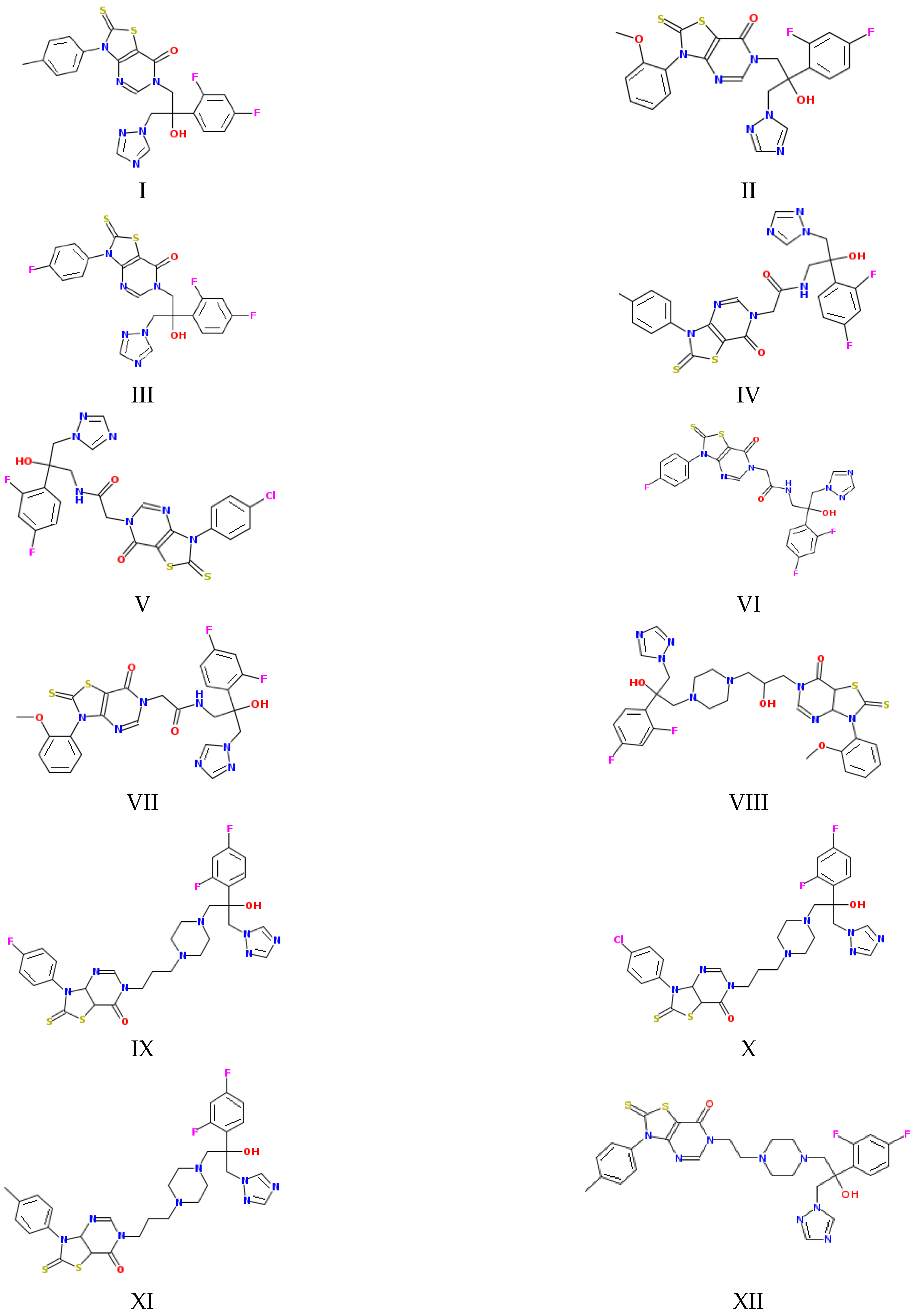
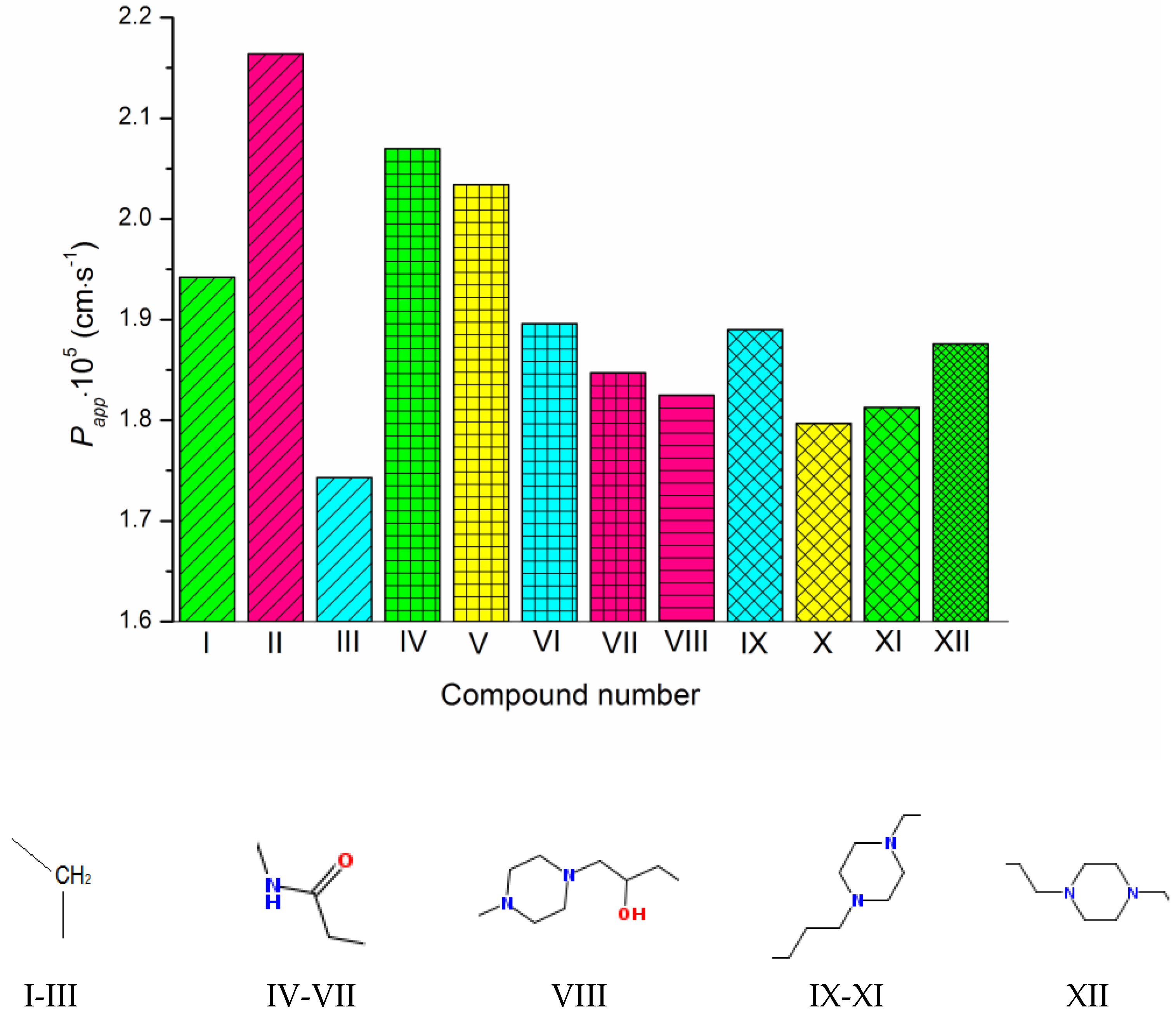
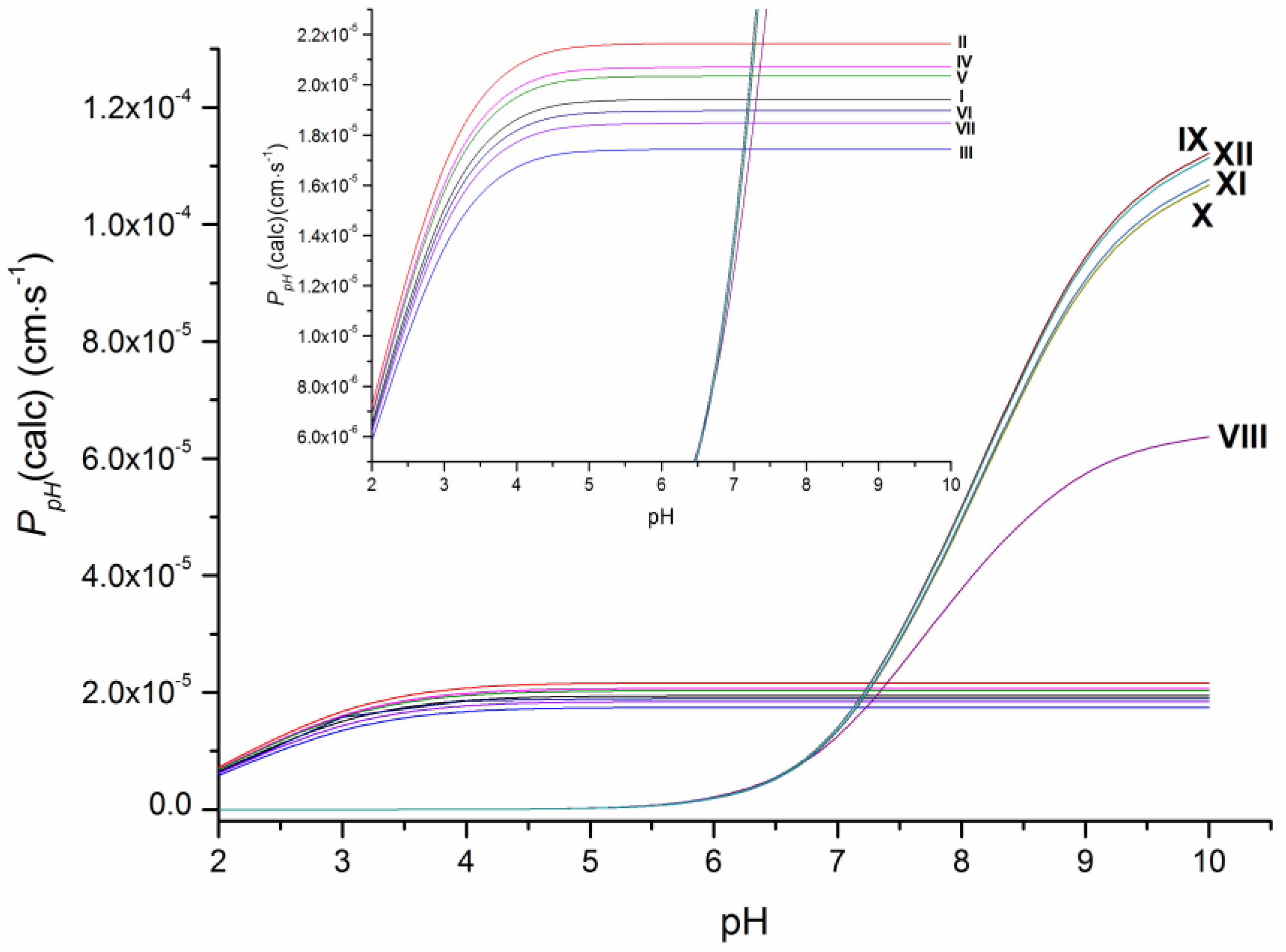
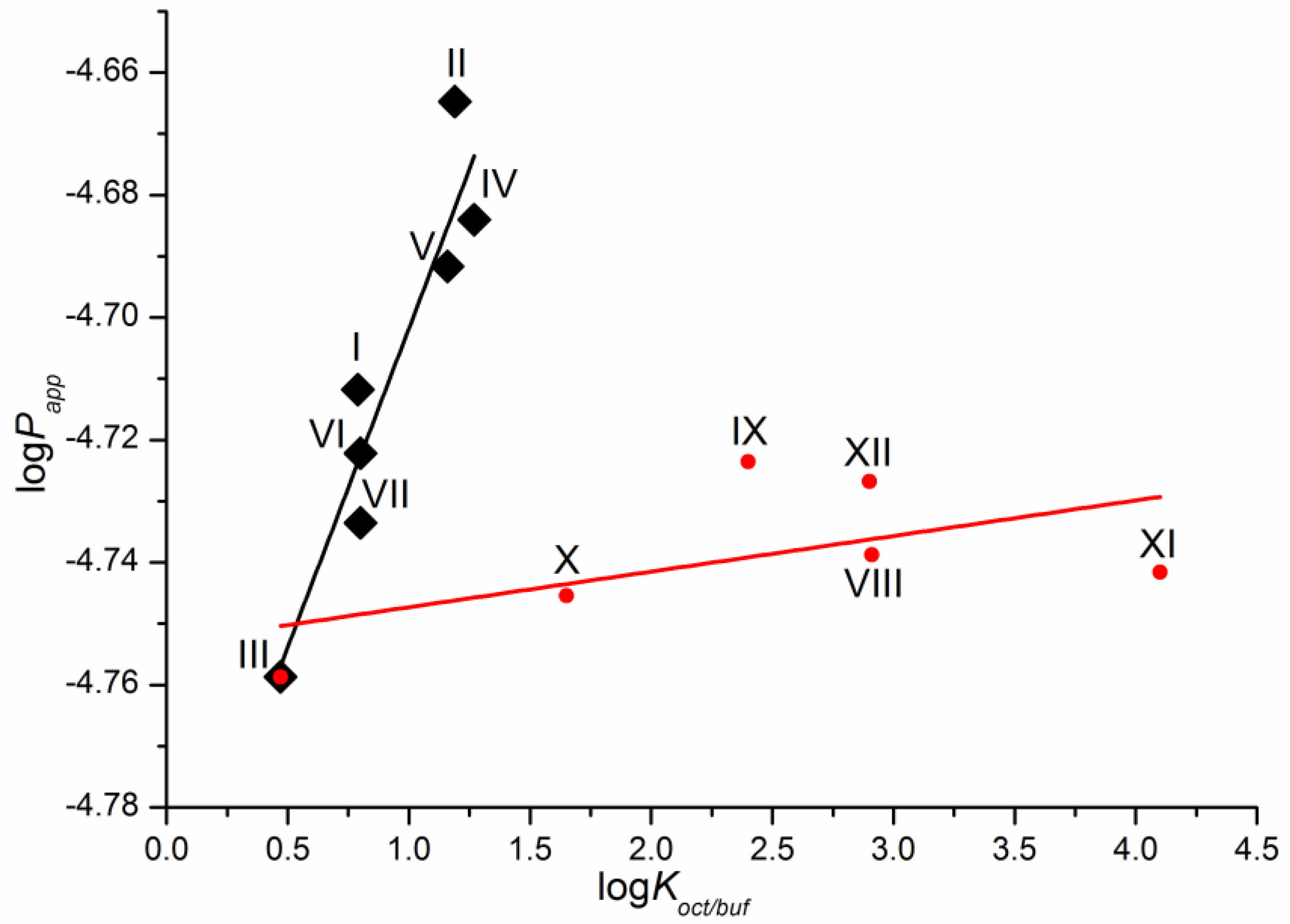
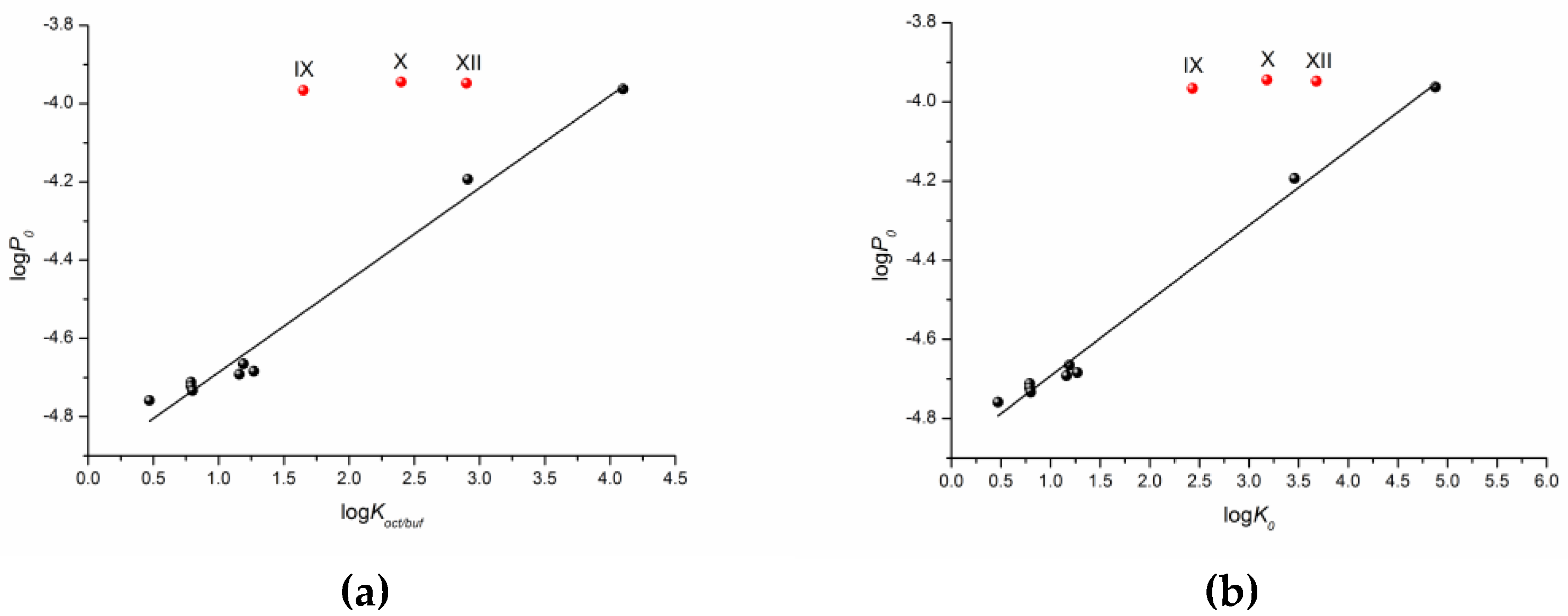
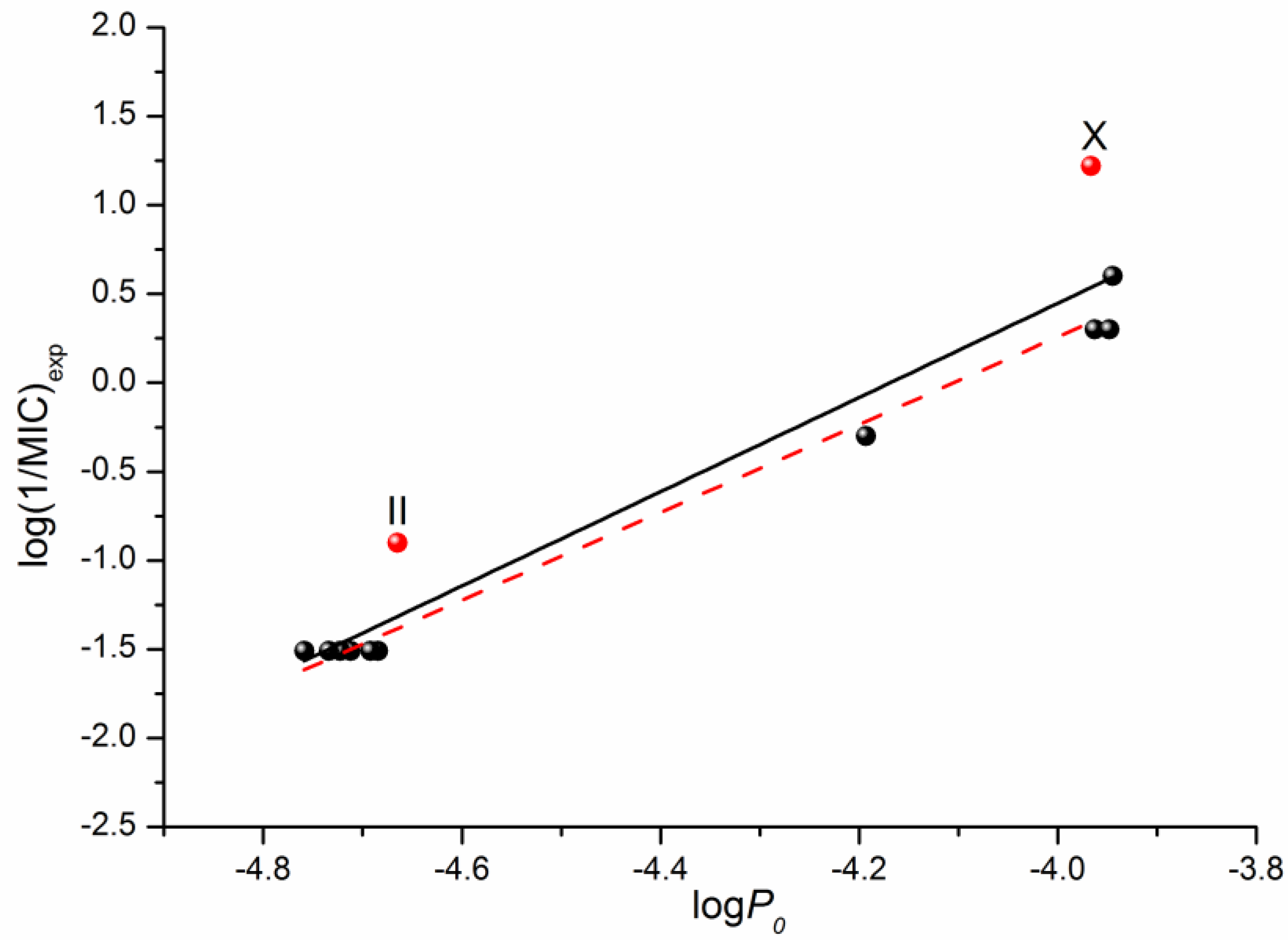
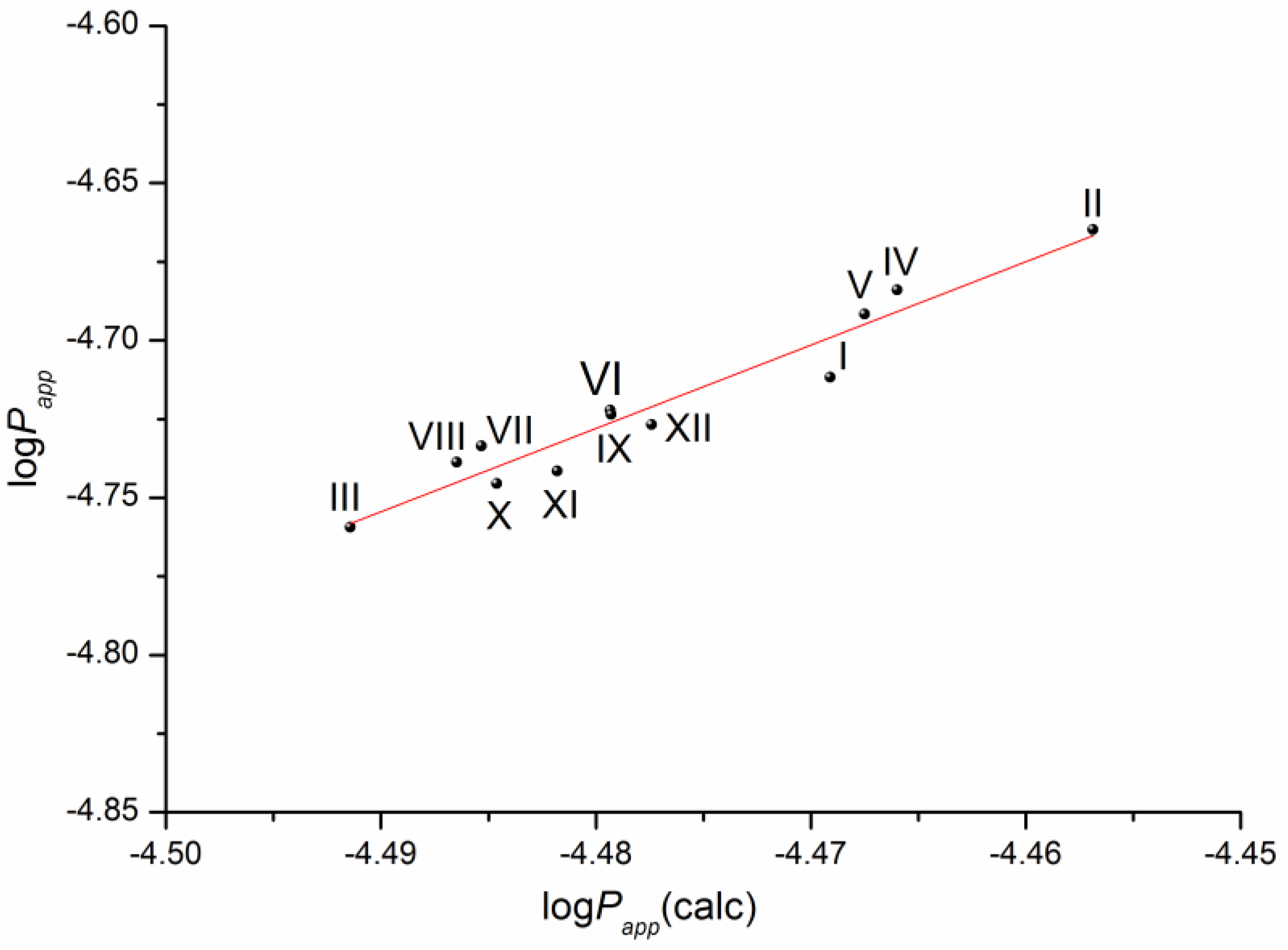
| № | Vvdw (Å3) a | Dw∙1010 (m2∙s−1) b | Doct∙1011 (m2∙s−1) b | logKoct/buf c | Papp⋅105 (cm∙s−1) c | P0 ⋅105 (cm∙s−1) d | PABL(calc)⋅105 (cm∙s−1) e | Poct(calc) (cm∙s−1) f | Papp(calc)⋅ 105 (cm∙s−1) g |
|---|---|---|---|---|---|---|---|---|---|
| I | 414.24 | 7.21 | 9.55 | 0.79 | 1.942 ± 0.078 | 1.942 | 3.60 | 5.89 × 10−4 | 3.40 |
| II | 423.22 | 7.16 | 9.48 | 0.47 | 2.164 ± 0.059 | 2.164 | 3.58 | 1.47 × 10−3 | 3.49 |
| III | 402.61 | 7.28 | 9.64 | 1.19 | 1.743 ± 0.047 | 1.743 | 3.64 | 2.85 × 10−4 | 3.23 |
| IV | 456.19 | 6.98 | 9.25 | 1.27 | 2.070 ± 0.074 | 2.070 | 3.49 | 1.72 × 10−3 | 3.42 |
| V | 453.16 | 6.99 | 9.27 | 0.79 | 2.034 ± 0.066 | 2.034 | 3.50 | 1.34 × 10−3 | 3.41 |
| VI | 444.56 | 7.04 | 9.33 | 1.16 | 1.896 ± 0.058 | 1.896 | 3.52 | 5.75 × 10−4 | 3.32 |
| VII | 465.17 | 6.93 | 9.19 | 0.80 | 1.847 ± 0.033 | 1.847 | 3.47 | 5.80 × 10−4 | 3.27 |
| VIII | 557.37 | 6.53 | 8.65 | 2.91 | 1.825 ± 0.058 | 6.409 | 3.26 | 7.03 × 10−2 | 3.26 |
| IX | 528.71 | 6.64 | 8.81 | 2.40 | 1.890 ± 0.064 | 11.36 | 3.32 | 2.21 × 10−2 | 3.32 |
| X | 537.31 | 6.61 | 8.76 | 1.65 | 1.797 ± 0.047 | 10.80 | 3.30 | 3.91 × 10−3 | 3.28 |
| XI | 540.34 | 6.60 | 8.74 | 4.10 | 1.813 ± 0.045 | 10.90 | 3.30 | 1.10 | 3.30 |
| XII | 523.53 | 6.67 | 8.83 | 2.90 | 1.876 ± 0.042 | 11.28 | 3.33 | 7.02 × 10−2 | 3.33 |
Disclaimer/Publisher’s Note: The statements, opinions and data contained in all publications are solely those of the individual author(s) and contributor(s) and not of MDPI and/or the editor(s). MDPI and/or the editor(s) disclaim responsibility for any injury to people or property resulting from any ideas, methods, instructions or products referred to in the content. |
© 2023 by the authors. Licensee MDPI, Basel, Switzerland. This article is an open access article distributed under the terms and conditions of the Creative Commons Attribution (CC BY) license (https://creativecommons.org/licenses/by/4.0/).
Share and Cite
Volkova, T.V.; Perlovich, G.L. Permeability of New Antifungal Fluconazole Derivatives through a Lipophilic Membrane: Experiment and Modeling. Molecules 2023, 28, 389. https://doi.org/10.3390/molecules28010389
Volkova TV, Perlovich GL. Permeability of New Antifungal Fluconazole Derivatives through a Lipophilic Membrane: Experiment and Modeling. Molecules. 2023; 28(1):389. https://doi.org/10.3390/molecules28010389
Chicago/Turabian StyleVolkova, Tatyana V., and German L. Perlovich. 2023. "Permeability of New Antifungal Fluconazole Derivatives through a Lipophilic Membrane: Experiment and Modeling" Molecules 28, no. 1: 389. https://doi.org/10.3390/molecules28010389
APA StyleVolkova, T. V., & Perlovich, G. L. (2023). Permeability of New Antifungal Fluconazole Derivatives through a Lipophilic Membrane: Experiment and Modeling. Molecules, 28(1), 389. https://doi.org/10.3390/molecules28010389







